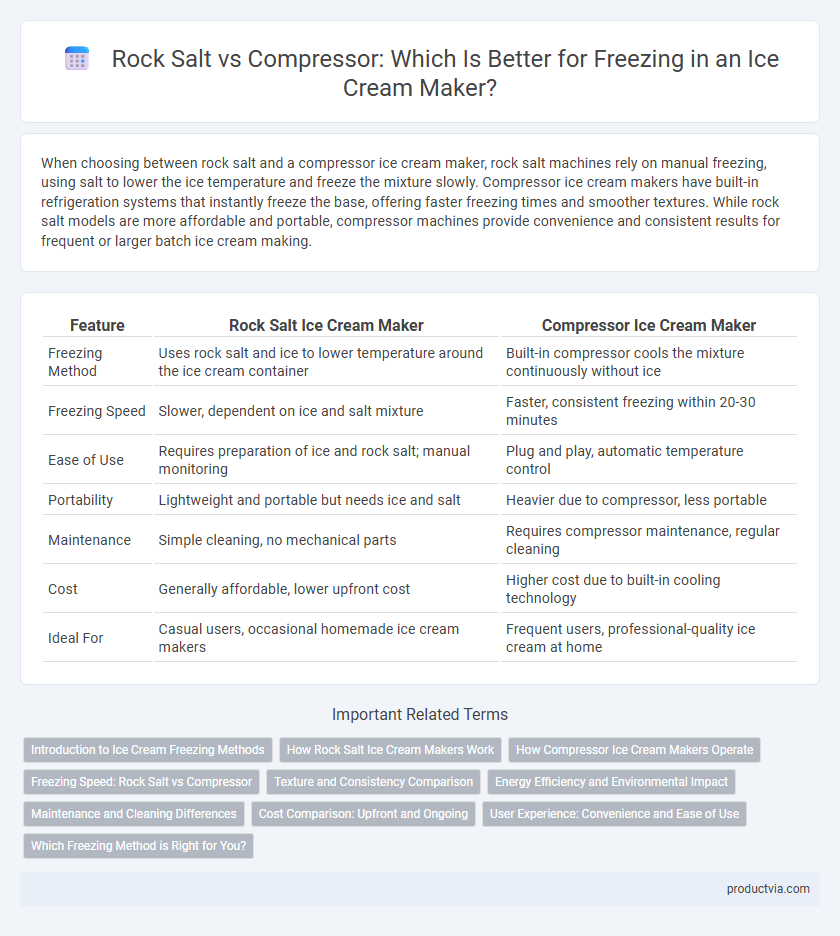When choosing between rock salt and a compressor ice cream maker, rock salt machines rely on manual freezing, using salt to lower the ice temperature and freeze the mixture slowly. Compressor ice cream makers have built-in refrigeration systems that instantly freeze the base, offering faster freezing times and smoother textures. While rock salt models are more affordable and portable, compressor machines provide convenience and consistent results for frequent or larger batch ice cream making.
Table of Comparison
| Feature | Rock Salt Ice Cream Maker | Compressor Ice Cream Maker |
|---|---|---|
| Freezing Method | Uses rock salt and ice to lower temperature around the ice cream container | Built-in compressor cools the mixture continuously without ice |
| Freezing Speed | Slower, dependent on ice and salt mixture | Faster, consistent freezing within 20-30 minutes |
| Ease of Use | Requires preparation of ice and rock salt; manual monitoring | Plug and play, automatic temperature control |
| Portability | Lightweight and portable but needs ice and salt | Heavier due to compressor, less portable |
| Maintenance | Simple cleaning, no mechanical parts | Requires compressor maintenance, regular cleaning |
| Cost | Generally affordable, lower upfront cost | Higher cost due to built-in cooling technology |
| Ideal For | Casual users, occasional homemade ice cream makers | Frequent users, professional-quality ice cream at home |
Introduction to Ice Cream Freezing Methods
Ice cream freezing methods vary primarily between using rock salt and a compressor system. Rock salt ice cream makers rely on the endothermic reaction of salt lowering the freezing point of ice, creating a cold environment to freeze the mixture effectively. Compressor ice cream makers use a built-in refrigeration unit for consistent temperature control, delivering smoother texture and faster freezing without the need for pre-freezing bowls.
How Rock Salt Ice Cream Makers Work
Rock salt ice cream makers use coarse rock salt to lower the freezing point of ice surrounding the canister, creating an ultra-cold environment that freezes the ice cream mixture efficiently. The salt disrupts the ice's molecular structure, causing it to melt while absorbing heat, which extracts warmth from the mixture inside, leading to faster freezing. This traditional method contrasts with compressor ice cream makers that rely on built-in refrigeration systems to maintain a consistent freezing temperature without external ice or salt.
How Compressor Ice Cream Makers Operate
Compressor ice cream makers operate by using a built-in refrigeration system that continuously freezes the mixture, eliminating the need for rock salt or pre-frozen bowls. This technology allows precise temperature control, resulting in smoother, creamier ice cream with faster freezing times. Unlike traditional rock salt methods, compressor models provide consistent performance and convenience for frequent ice cream makers.
Freezing Speed: Rock Salt vs Compressor
Compressor ice cream makers freeze mixtures faster by maintaining a consistent low temperature, rapidly solidifying the ice cream base. Rock salt ice cream makers rely on a salt-ice mixture to lower freezing points but take longer due to fluctuating temperatures. Compressor models provide quicker freezing speeds, resulting in smoother textures and reduced wait times.
Texture and Consistency Comparison
Rock salt ice cream makers produce ice cream with a slightly grainier texture due to uneven freezing caused by manual salt application and ice melting rates. Compressor ice cream makers maintain consistent, smooth texture and creaminess by continuously freezing the mixture with precise temperature control. The compressor's ability to churn and freeze simultaneously ensures uniform consistency, making it superior for achieving premium ice cream quality.
Energy Efficiency and Environmental Impact
Rock salt ice cream makers rely on natural freezing through salt and ice mixtures, consuming no electricity but requiring frequent replenishment of ice, which can be less energy-efficient in large-scale use. Compressor ice cream makers utilize built-in refrigeration systems that consume electricity but offer consistent freezing with lower overall environmental impact by reducing ice waste and improving energy efficiency with modern inverter technology. Choosing between the two involves weighing the zero-electricity benefit of rock salt against the energy-optimized operation and reduced resource consumption of compressor models.
Maintenance and Cleaning Differences
Rock salt ice cream makers require frequent replenishment of rock salt and water, producing a salty residue that demands thorough cleaning after each use to prevent corrosion. Compressor ice cream makers feature sealed, self-contained systems with smooth surfaces, allowing for easier wiping and less frequent maintenance compared to the salt-based models. Users of compressor machines benefit from simpler upkeep routines, avoiding the gritty cleanup associated with rock salt containers and ensuring longer-lasting appliance performance.
Cost Comparison: Upfront and Ongoing
Rock salt ice cream makers generally have a lower upfront cost, making them an affordable choice for casual users, while compressor models require a higher initial investment due to advanced refrigeration technology. Ongoing expenses for rock salt machines include regular purchases of rock salt and ice, which can accumulate over time, whereas compressors incur higher electricity costs but save on consumables. Considering long-term use, compressor ice cream makers offer cost efficiency through convenience and faster freezing, despite higher energy consumption.
User Experience: Convenience and Ease of Use
Rock salt ice cream makers require manual preparation and frequent stirring, which can be time-consuming and messy, impacting user convenience. Compressor ice cream makers offer a hands-free experience with built-in refrigeration, allowing users to make multiple batches without waiting for pre-freezing. The seamless operation of compressor models significantly enhances ease of use, making them ideal for those seeking quick and effortless ice cream preparation.
Which Freezing Method is Right for You?
Choosing between rock salt and compressor freezing methods depends on your priorities and usage frequency. Rock salt ice cream makers require manual ice and salt layering to achieve freezing temperatures, ideal for occasional use and traditional recipes. Compressor models offer consistent temperature control with built-in refrigeration, making them suitable for frequent use and precise texture results.
Rock salt vs Compressor for freezing Infographic

 productvia.com
productvia.com